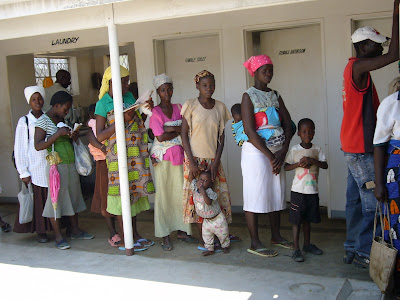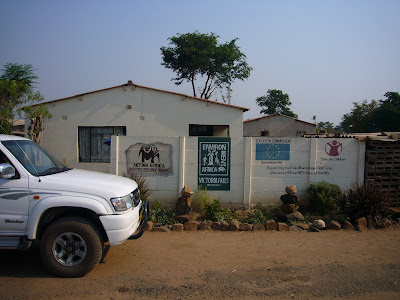From October 12
th through the 15th, I participated in the Ministry of Health’s outreach program for registering of all HIV positive persons, testing for HIV, counseling services for pre and post testing and pre-ART (antiretroviral treatment), and distributing of ARV's (antiretroviral medications) for the Hwange district. The program involved seven clinics in the Hwange area: Mabale, Dinde, Lukosi, Kanywambezi, Jambezi, Ndlovu, and Chisuma clinics. The whole group conducting the outreach program included Daniel, a driver from Environment Africa, Sister Masenga, a senior nurse from Vic Falls Hospital, Mrs. Dube, a councilor from Vic Falls Hospital, Lorren from Environment Africa, an opportunistic infections nurse from Vic Falls Hospital, a pharmacist from Congo, and me. We also had ten boxes of testing supplies, registers, medical supplies, and drugs that we distributed to all of the clinics. As for my role in all of this, I tagged along with a different group of people each day to help with the various tasks and basically did whatever needed help doing.
The previous week, we visited each clinic involved in the outreach program and taught the local nurses how to use the new HIV registers, as well as asked them to mobilize their treatment area for the actual outreach visits this week. This is no easy task seeing that, on average, each clinic serves the surrounding 30km area and up to 6000 individuals. The result was generally a resounding success. Difficulties arise from both getting all the patients that need testing, counseling, and supplies treated and organized in one day and from discouraging everyone from the catchment area flooding the clinic on the designated day (not only patients) simply because having any outsiders come constitutes an event of some note.
 |
| Moblilzation visit, from left: Mrs. Dube, Daniel, Sister Masenga (sitting), local nurses, and me (melting in the corner) |
At Mabale clinic on the first day, I stayed with Sister Masenga and Lorren and helped by recording and registering all HIV positive individuals. Zimbabwe does not have enough money to treat every person who tests positive for HIV; as a result, their treatment system is based on CD4 counts and the onset of AIDS. Patients are only eligible for ART if their CD4 count is less than 350. Even after they are immuno-compromised enough to warrant drugs, the patients are required to attend four teaching sessions on how to take ARV’s and what to do about side effects, pass questioning about taking ARV’s, and have no current opportunistic infections before they are actually started on ART. Registration of the patients involved taking their name, age, OI registration number (given to each person as they test positive for HIV), and their current treatment regimen.
 |
| Sister Masenga addressing a group of patients before counseling |
The next day, at Kanywambezi clinic, I stayed with Mrs. Dube and the OI (opportunistic infection) nurse for PMTCT (parent or mother-to-child transmission) counseling and HIV testing. An HIV positive diagnosis is given after a positive antibody test, as well as a more specific test for the strain of HIV (1 or 2) are completed. The antibody test used is called “Determine” and consists of a small test strip where a few drops of blood are placed along with a buffer. The OI nurse conducted the testing which involved the person being tested getting pricked in the thumb with a small disposable lancet, placing the blood and buffer on the test strip, and waiting fifteen minutes to identify a positive or negative result.
 |
| Packet of 100 Determine antibody tests for HIV |
 |
| A negative Determine test, the second line is a control (a positive test would also show a line in the first white space) |
The second test, for the specific strain of HIV, called the SD Bio Line test, is only administered after a positive Determine test result. On this day, we only used the Determine tests.
 |
| SD Bio Line Test |
At Kanywambezi I also sat in on pre-ART adherence counseling sessions conducted by Mrs. Dube. As I mentioned before, after having a CD4 lower than 350, patients must attend four of these sessions, then answer questions about taking the drugs correctly before they are started on ART.
 |
| Counseling session. I particularly like this picture because the gentleman second from the left has an INSPI(RED) AIDS campaign shirt on (I think its a ladies shirt but no matter) |
On October 14th, at Dinde clinic, I helped Mrs. Dube and the OI nurse again with HIV testing and recording the statistics and demographics of who we tested their test results (men as compared with women and children as a separate category). Unfortunately, so many people showed up for testing, that we were unable to get to them all. The number of people able to be tested is limited both by the fifteen-minute wait before test results, and mainly by individual post-test counseling required by law. Luckily, most of the people tested on this day were HIV negative; the odd thing is that most of those who tested negative were surprised by their results. Perhaps they were surprised because of questionable behavior they engaged in prior to testing. It made me wonder. A positive observation about the overwhelming number of people who came for testing is that, at least in this area, the taboo against getting tested appears to be almost completely gone.
 |
| Dinde Clinic |
 |
| People waiting outside the clinic to be tested |
 |
| More people in line to be tested... |
 |
| Even more people waiting to be tested right outside the door |
After Dinde, we packed up and headed to Lukosi Hospital for the second round of distribution for the day. This time, I stayed with the pharmacist and learned about the drugs that we were dishing out. Everyone who tests HIV positive is given cotrimoxazole, a broad-spectrum antibiotic, to take constantly as a preventative measure against opportunistic infections. I helped out by labeling the prescription bags and filling them with a two-month supply of sixty tablets.
 |
| The pharmacist, with his registers. (the 'office' we had to use was the x-ray suite, the desk is actually the x-ray table) |
 |
| Prescription baggies of cotrimoxazole (cotri for short) |
In addition, if a particular patient also needs ART, they are supplied with the specific medicine or combination they need. There are three different lines of HIV treatment drugs; the first, and most common, is a generic trisome treatment (combination of three drugs). The second line drugs, two different types of pills, are needed when a person on ART is also being treated for tuberculosis as the TB treatment drugs interact poorly with first line ART. The third line drugs are the rarely-to-almost-never used and extremely expensive HEART (highly effective antiretroviral treatment) drugs, for difficult cases of AIDS. Trisome treatment and cotrimoxazole are also made in junior and baby-liquid forms for HIV positive kids sick enough to need ART. Thankfully, there are few of these, although we did distribute about ten junior trisome and two baby trisome prescriptions.
 |
| Boxes of ART drugs, the light blue labels are the junior trisome, the pink are the baby trisome and the orange are the second line ART. |
The last day of the outreach program saw us at Ndlovu and Chisuma clinics. At Ndlovu, the nurses misunderstood the mobilization instructions from the previous week, and unfortunately only six people showed up for registration and resupply of their medication. The nurses thought that only the patients needing refills this specific week were to come, instead of all persons who are HIV positive. A a result, we will need to come back at a later date to fulfill the registration requirements set by the government. At Chisuma clinic, there was a better turnout. Once again, I helped sister Masenga and Lorren with the registration of all HIV positive people by keeping a record for the Environment Africa files. This wrapped up the outreach program for the time being. We will make another visit to each clinic at the end of November to register anyone who did not show up during these visits, but other than that, the program was sucessfully concluded.








































